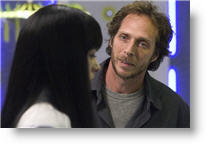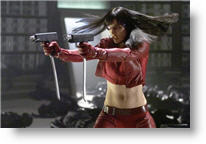Ultraviolet
 for sequences of violent action throughout, partial nudity and language.
for sequences of violent action throughout, partial nudity and language.
Reviewed by: Michael Karounos
CONTRIBUTOR
| Moral Rating: | Offensive |
| Moviemaking Quality: |
|
| Primary Audience: | Mature-Teens Adults |
| Genre: | Sci-Fi Horror Action |
| Length: | 1 hr. 28 min. |
| Year of Release: | 2006 |
| USA Release: |
March 3, 2006 (wide) |









| Featuring |
|---|
|
Milla Jovovich Cameron Bright, Nick Chinlund, William Fichtner, Sebastien Andrieu, Ida Martin, Ricardo Mamood, Don Ferguson |
| Director |
|
Kurt Wimmer |
| Producer |
|
John Baldecchi Pauline Chan Ultravi Productions Screen Gems |
| Distributor |
“The blood war is on.”
“Ultraviolet” is the worst movie I have ever seen. One of my students, whose eclectic tastes include films by political hatchet men Quentin Tarantino and Lars Von Trier, also said it was the worst movie that he had ever seen. To complete the inter-generational critique, an anonymous 15 year old posted a comment on the IMDB Web site swearing that it’s the worst movie that he had ever seen, too.
Despite the small statistical sampling reflected by those three opinions, such a passionate consensus indicates that there must be something desperately rotten in Denmark besides Lars Von Trier’s movies.
Practically speaking, the dialog and acting are just horrible. Wimmer scrapes the bottom of the casting bucket in selecting some actors who have only two credits in their filmography, and he doesn’t even bother to change the name of three of those people, allowing their characters to retain the names of the actors. Since one of his characters is named “Six” this may reflect Wimmer’s inability to invent fictional names. Be that as it may, the writing and the delivery are abysmal. This may also be attributed to the fact that Wimmer suffers from George Lucas syndrome in which he tries to do everything. In both “Ultraviolet” and “Equilibrium”, Wimmer is a triple-threat to good taste and common sense: writing, directing, and acting. [Memo to George Clooney and Kurt Wimmer: you are not Clint Eastwood.]
Cinematically, I’ve never seen such a sterile-looking movie. There’s nothing in it that looks authentic, although everything is supposed to. Its form, like its content, is full of empty spaces populated by CGI architectural elements masquerading, I believe, as people. Worse, the movie defies narrative logic. To paraphrase Gertrude Stein’s comment about Oakland, there is no montage there. The movie consists of disconnected scenes whose only common feature are the actors.
Kurt Wimmer established a small cult following with the movie “Equilibrium”, whose tagline is “In a future where freedom is outlawed outlaws will become heroes.” The anti-hero as savior is the one note that he beats relentlessly. My review of the movie (http://www.unomaha.edu/jrf/Vol7No2/reviews/equilibrium.htm) observes that “Equilibrium” uses a lexicon of “Cleric,” “Father,” “savior,” “faith,” and “true believer” to characterize the fascist guardians of religious sensibility who have banned emotion-inducing art, literature, and music.
Additionally, Wimmer uses a T-shaped cross to reinforce the idea that fascism and Christianity are ideologically identical, apparently ignorant of the fact that Germany’s National Socialist Party was the flip side of the Communist Socialist Worker’s Party. More to the point, Wimmer purposely ignores the common dependency of Marxism and Nazism on propaganda as a medium, or their dependency on concentration camps as a mode of economic production. But why let facts get in the way of the lie?
In “Ultraviolet” Wimmer’s anti-Christian obsession with crosses becomes a parody of itself. There are cross symbols everywhere—on the walls, on the elevators, on the tile floors, on the uniforms of the fascist-looking guards. Even some of the doors are cross-shaped, for goodness sake’s. I like crosses, but there’s just too much of a good thing in this movie.
Continuing the anti-Christian theme, the evil Daxus (Nick Chinlund) is the “vice-cardinal” whose building, the “arch-ministry,” is itself a giant white cross containing all his “mansciples” (yes, Wimmer actually coined that word). This, presumably, is a dual-purpose reminder of the nexus between Christianity and the Pentagon, since it was an “American weapons laboratory that created stronger, better soldiers.” The abortive result was the “hemophage” (Greek for “blood-eater”).
The film takes place in an “age where terrorism has been replaced by fear.” For those unfamiliar with paranoid leftist fantasies, this is code language meaning that The Patriot Act is more to be feared than Jihadi terrorism. Hence, the political entities in this one-dimensional film are the evil (American) humans and three different kind of hemophages: the Blood Chinois (a Chinese gang), a French group, and Violet (Milla Jovovich). Helping Violet is another hemophage, Garth (William Fichtner), whose scruffy face and fangs make him look more terrier than vampire. Apparently we are to deduce that in Wimmer’s world the Americans, French, and Chinese all represent selfish global interests which noble idealists like Violet do their best to defeat, and can defeat, because, well, they’re angrier. There are also scattered references to resurrection, cloning, and WMD’s, to name several topics that Wimmer isn’t qualified to make movies about. Mercifully, they are given short shrift, since Wimmer has nothing intelligent to say about them.
One can’t say anything critical enough about such a horrible movie. Worse than bad, it is fraudulent. Wimmer, whose favorite book is Mark Twain’s Tom Sawyer, commits an ethical transgression by promising to deliver a movie and instead producing the CGI equivalent of The Royal Nonesuch from Twain’s Huck Finn. The King and Duke were tarred and feathered for their fraudulent acting, and it makes one wish that Twain were here to write about fraudulent directors, too. In the memorable words of Oscar Wilde, you would have to have a heart of stone to see this movie and not cry or laugh in all the wrong places.


Offensive / 2
…As for a review of the film itself, it is (as mentioned earlier) style over substance. It features such CGI nonsense as a motorcycle riding up the side of a building! Our “heroine” manages to butcher no fewer than 700 people in the movie, but interestingly enough, without blood. In fact, we do not actually see the overwhelming majority of deaths. Usually we see her swinging her sword, the camera pans back, we hear noises, and then the camera comes back to see her standing around forty or fifty dead bodies with her sword “striking a pose.” Hokey? Yes. Worst movie ever? Rent a Tarantino movie, or one of this year’s academy award nominees? Or for that matter Milla’s last couple of “Resident Evil” movies. … Movie plot : D / Directing : C+ / Cinematography : B+ / Acting : B- / Overall, score : C
Offensive / 3
Extremely Offensive / 1
Average / 5
Average / 4

My Ratings: Average / 3